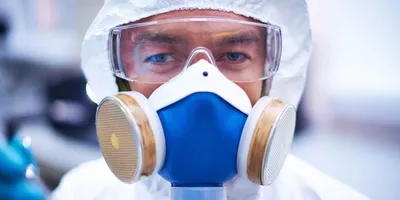Each November, campaigns like No Shave November and Movember encourage participants to grow facial hair to raise awareness for men’s health, cancer research, and mental well-being. For many, these efforts represent camaraderie and advocacy. But in laboratory environments—where respirator use is often required—these campaigns also bring attention to a very practical concern: how facial hair affects safety.
For lab professionals who wear tight-fitting respirators, beards and stubble can interfere with the mask’s seal, reducing protection against hazardous substances. Yet, some individuals cannot shave for medical, religious, or cultural reasons, underscoring the importance of flexible and inclusive safety policies.
Why facial hair impacts respirator protection
Tight-fitting respirators, such as N95s, half-face elastomeric, and full-face models, protect workers by forming a secure seal between the mask and the wearer’s skin. According to the National Institute for Occupational Safety and Health (NIOSH), even minimal facial hair along that sealing surface can break the seal and allow particles, vapors, or pathogens to bypass the respirator. Studies have shown that short stubble—just a day or two of growth—can significantly reduce protection.
However, loose-fitting respirators, such as powered air-purifying respirators (PAPRs), can offer protection without requiring a tight seal. PAPRs may be appropriate for individuals who maintain facial hair for cultural or medical reasons, though they may not be practical or affordable for all lab settings.
Supporting awareness campaigns while maintaining safety
Participating in awareness campaigns doesn’t have to come at the expense of protection. Federal safety experts emphasize that facial hair along the respirator’s sealing area compromises performance, but creative grooming choices—such as a neatly trimmed mustache, goatee, or soul patch—can often allow participation while keeping respirators effective.
Both No Shave November and Movember promote engagement in any form, whether through conversation, donation, or creative expression. Lab managers can remind staff that these campaigns are about awareness, not necessarily growing a full beard, and that workplace safety must always take precedence in regulated environments.
Recent research efforts have also examined how respirator fit could be improved for workers who cannot shave. Federal agencies and industry partners have explored materials and design techniques that could make respirators more adaptable, reflecting a broader effort to ensure equitable personal protective equipment (PPE) access for all workers.
Building inclusive safety programs in the lab
For lab leaders, November offers an opportunity to revisit how safety programs accommodate individual differences. An inclusive safety culture considers not just regulatory compliance but also the diverse backgrounds and needs of laboratory personnel.
Practical steps for managers include:
- Reviewing respirator fit-testing requirements and communication around facial hair policies
- Offering PAPRs or other alternatives when possible
- Reinforcing seal-check procedures and PPE training for all staff
- Encouraging participation in awareness campaigns through creative, compliant options
- Fostering dialogue about cultural or medical accommodations related to PPE use
Balancing participation and protection
Awareness campaigns like No Shave November and Movember do more than promote men’s health—they also invite meaningful conversations about equity, inclusion, and safety in the workplace. As safety researchers continue exploring ways to make respirators more inclusive, laboratory leaders can model empathy and flexibility while maintaining compliance. By balancing participation with protection, lab managers can ensure that every team member—bearded or not—feels both seen and safe.
This article was created with the assistance of Generative AI and has undergone editorial review before publishing.












